ROMé DE L'ISLE, Jean-Baptiste Louis.
(1736 – 1790)
Romé de I'Isle received little formal scientific education-his interest in natural history developed during his military service and travel in India and the Orient. In 1764 after his return to France, he was befriended by the mineralogist and chemist B. Sage, who directed his interest to mineralogy. Romé de I'Isle supported himself through the patronage of several wealthy friends whose collections of minerals, coins, and gems he supervised and cataloged. Although his scientific work became well known outside of France, he never succeeded in breaking into the French scientific establishment. A proposal for his election to membership in the Académie des Sciences failed and he lived to see his own achievements in mineralogy and crystallography overshadowed by the work of R.J. Haüy.
Biographical references: ABF: I 908, 401-411. • Beauchamp, Biographie Moderne, 1816. • Biographie Universelle: 38, 521-3 [by C.S. Weiss]. • DSB: 11, 520-4 [by R. Hooykaas]. • Feller, Biographie Universelle, 1851. • Observations sur la Physique, sur l'Histoire Naturelle et sur les Arts: 36 (1780), 315-23 [obituary by J.C Delamétherie]. • Poggendorff: 2, cols. 682-3. • Stouffs, Inventaire des Papiers du Didot, 1963. • WBI.
Catalogue Systématique et Raisonné des Curiosités de la Nature et de L'Art, Qui composent le Cabinet de M. Davila, Avec Figures en taille douce, de plusieurs morceaux qui n'avoient point encore été gravés. (3 vols., Paris, 1767).See under: Dávila, Pedro Franco.
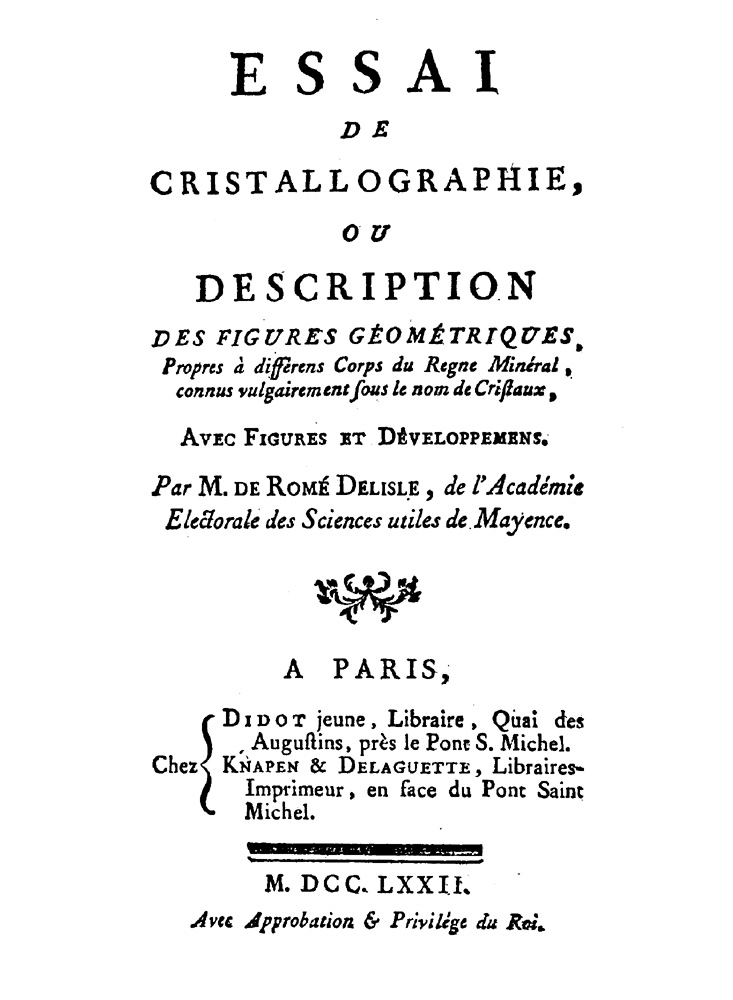
1. French, 1772 [First edition].
Essai | De | Cristallographie, | Ou | Description | Des Figures Géométriques. | Propres à différens Corps du Regne Minéral, | connus vulgairement sous le nom de Cristaux. | Avec Figures et Développemens. | Par M. de Romé Delisle, de l'Academie | Electorale des Sciences utiles de Mayence. | [ornament] | A Paris, | [The next 5 lines braced on the left-hand side by "Chez {"] Didot jeune, Libraire, Quai des | Augustins, près le Pont S. Michel. | Knapen & Delaguette, Libraires- | Imprimeur, en face du Pont Saint | Michel. | [double rule] | M. DCC. LXXII. | Avec Approbation & Privilége du Roi.
4°: a8 b8 A-Z8 2A-2C8 2D7 (a1 blank); 230l.; [iii]-xxxii, [1]-427, [2], [1] blank p., ten engraved plates (numbered I-X), 2 folding tables. The plates show various crystal forms and diagrams. Page size: 242 x 188 mm.
Contents: [iii-iv], Half title page, "Essai | De | Cristallographie," verso "[rule] | Natura Geometriam exercet sub terræ visceribus | mirabili opifico! Encelius De Re Metall. lib. I."; [v-vi], Title page, verso blank.; [vii]-viii, Dedication-signed Romé Delisle.; ix-xvi, "Préface."; xvii-xxviii, "Table Alphabétique des princi- | paux Auteurs qui ont écrit sur les Cristaux, ou | qui sont cités dans cet Ouvrage à l'occassion des | Cristaux ..."; xxix-xxx, "Explication des Termes Géométriques | employés dans ces Ouvrage."; xxxi-xxxii, "Distribution | des Cristaux."; [1]-42, "... Discours Préliminaire."; [43]-105, "Premiere Partie."; [106]-284, "Seconde Partie."; [285]-323, "Troisieme Partie."; [324]-381, "Quatrieme Partie."; 382-384, "Table des Affinités des Cristaux, suivant M. | le Chevalier Linné, tirèe de la XIIe Edition du | Systême de la Nature, tome 3, p. 218 & suiv."; 385-390, "Errata."; 391-427, "Table | Des Matieres."; [2 pgs], "Approbation" and "Privilege Du Roi."; [1 pg], Blank.; [At end], 2 folding tables and 10 plates numbered I-X.
Very scarce. The Cristallographie ranks as one of the great contributions to the science of crystals. In it Romé de l'Isle attempted to make a comprehensive classification of crystals. By the time he wrote this volume, he was extremely familiar with the subject, and this work greatly supassed all previous works in scope and detail. To apply his classification, he adopted a morphological approach in which he attempted to relate the diverse forms of crystals of the same substance. As a general morphological concept he introduced the idea of the "primitive form." All crystals of the same inorganic substance, no matter how different in appearance had a fundemental and common geometrical form-the primative form-to which their actual crystal shapes related. The justification for this idea was derived from the previous work of Carl Linneaus who had tried to expain the genesis of minerals by means of an analogy with the procreation of living creatures, and classified cystals by the similarities of their crystallized forms.
In this first edition of the Cristallographie, Romé de l'Isle identifies 110 crystal forms by which minerals crystallize. Grouped under each of these shapes are described the minerals that exhibit similar habit, including the approximate angles between crystal faces. These forms were all derived form a common saline ingrediaent in every mineral that worked at a molecular level. Although he believes that these primitive forms existed, it is never made clear how they should be defined for any group of crystals. Romé was able to greatly expand upon this idea in the second edition [which see below].
An annotated bibliography compiled by Romé is listed on pages xvii-xxviii.
Bibliographical references: Berlinische Sammlungen: 9, 414-5. • Burke, Origins of the Science of Crystals, 1966: 69-71. • Dana's 7th (Bibliography): 69. • DSB: 11, 520-4 [by R. Hooykaas]. • Freilich Sale Catalog: nos. 460-1. • Hoover Collection: no. 691. • Hooykaas, R., "De kristallografie van J.B. de Romé de l'Isle (1783)", Chemisch Weekblad, 47, (1951), 848-55 [Comparison between Romé's crystallography and his theories of crystal chemistry.]. • Hooykaas, R., "De oudste kristallografie", Chemisch Weekblad, 46, (1950), 438-40. • Hooykaas, R., "De oudste kristallografie-Translated", Revue d'Histoire des Sciences, 12, (1959), 182-5. • Hooykaas, R., "Romé de l'Isle en de structuur theorie", Chemisch Weekblad, 47, (1951), 909-14. • Hooykaas, Species Concept in Mineralogy, 1952: 45-55. • LKG: IX 9. • Marx, Geschichte der Crystallkunde, 1825: 120-31. • Mauskopf, Crystals and Compounds, 1976: 9-19. • Metzger, Genèse de la Science des Cristaux, 1918: 65-75 & 189-92. • Norman Catalog: 2:1847. • Norman Sale Catalog: 3:757. • Physikalisch-Oekonomische Bibliothek: 4 (1774), 135-7 & 8 (1778), 393-4. • Wellcome Catalog (Books): 4, 553.

2. French, 1783 [2nd edition].
Cristallographie, | Ou | Description | Des Formes Propres A Tous Les Corps | Du Regne Minéral, | Dans l'état de Combinaison saline, pierreuse | ou métallique, | Avec Figures & Tables Synoptiques de tous les Cristaux connus. | Par M. De Romé de l'Isle, de l'Academie Impériale des Curieux | [...3 lines of titles and memberships...] | Seconde Édition. | [rule] | [...2 lines of quotation, signed Torbern Bergman...] | [rule] | Tome Premier [-??]. | [ornament] | A Paris, | De L'Imprimerie De Monsieur. | [double rule] | M. DCC. LXXXIII.
4 vols. [Vol 1] 8°: a-b8 c4 A-2Q8; 332l.; [i]-xxxviii, [2], [1]-623, [1] p.; [Vol 2] 8°: π2 A-2S8 2T2; 332l.; [4], [1]-659, [1] p.; [Vol 3] 8°: π2 A-2P8 2Q2; 308l.; [4], [1]-611, [1] p.; [Vol 4] 8°: a8 A-L3 M-Q8; 48l.; [i]-xvi, [1]-80 p., 12 folding plates (bound after a8) and accompanying tables. Page size: 196 x 125 mm.
Contents: [Vol 1] [i-ii], Half title page, verso "Se trouve | Chez ..."; [iii-iv], Title page, verso blank.; [v]-x, Dedication to the Royal Prussian Academy of Science, signed Romé de L'Isle.; [xi]-xxxviii, "Préface."; [2 pgs], "Approbation" and "Privilège Du Roi."; [1]-103, "Introduction."; [104]-425, "Première Partie. | Des Cristaux Salins."; [426]-623, "Seconde Partie. | Des Cristaux Pierreux."; [1 pg], Blank.
[Vol 2] [i-ii], Half title page, verso "Se trouve | Chez ..."; [iii-iv], Title page, verso blank.; [1]-522, Continuation of section on stones from volume one.; [523]-659, "Appendice | A La | Seconde Partie."; [1 pg], Blank.
[Vol 3] [i-ii], Half title page, verso "Se trouve | Chez ..."; [iii-iv], Title page, verso blank.; [1]-490, "... Troisième Partie. | Des Cristaux Métalliques."; [491]-563, "Table Alphabétique | Des Matieres | Contenues dans les quatre Volumes de | la Cristallographie."; [564]-609, "Table Alphabetique | des | Principaux Auteurs."; 610-611, "Errata."-to all volumes.; [1 pg], Blank.
[Vol 4] [i-ii], Title page, verso blank.; iii-iv, "Avis Au Relieur."; [v]-xvi, "Table Synoptique | Des | Trois Premiers Volumes | De La Cristallographie."; [Plates and tables].; [1]-34, "Explication | Des | Figures Géométriques | Dè la Planche VIII."; 35-48, "Tableau | Des Principaux Angles (I) | Que Présentent Les Cristaux."; 49-80, "Noms | Des Substances Salines, | pierruses ou métalliques, auxquelles | ..."-being a series of tables listing the names of the minerals figured on the plates.
Very scarce. Contains the first general announcement of the fundemental law of quantitative crystallography. This is a revised and greatly expanded edition of Essai de Cristallographie (Paris, 1772), and although the title page calls this publication a second edition, it has been so greatly enlarged, it could rightly be considered as a separate work. By the time of its publication, Romé had made crucial advances towards a quantitative crystallography. This had been made possible by the recent invention of the contact goniometer[1] by his student, Arnould Carangeot [see note below]. This simple device used for measuring crystalline angular dimensions, led him to generally enunciate for the first time, the fundemental quantitative law of crystallography-the law of constant interfacial angles.
Previously, Henckel, Bartholin and Steno had observed this constant in pyrite, calcite and quartz, respectively; however, Romé was the first to state it as a general trueism of the physical world. It meant that regardless of the dissimilar appearance of crystals, specimens of the same species would always show identical angle measurements between common crystal faces. In addition, this discovery provided mineralogy with the first exact measurement that could be published without interpretation, and thus be disseminated to other researchers. To this purpose, this edition increases to over 450 the number of possible crystal forms, and providing for each accurate angle measurements between different crystal surfaces made with the goniometer. Armed with his law, he was able to somewhat elaborate on his definition of the primitive form and how it related to the external crystal, but Romé never made the theoretical leap that allowed Haüy to spin an elegant theory from essentially the same information. None the less, Romé captured information from his crystallographical laws and together with his broadened concept of the relationship between crystal form and chemical composition, he made the Cristallographie into the finest mineralogical treatise written to the time.
Volume 1, part 1: Salts, acids, alkalines, bases and combinations.; Volume 1, part 2: Crystallization of stones. i.e. gypsum, selenite, calcite. Volume 2: Quartz, tourmaline, feldspar, gems, etc. an appendix deals with rocks and other aggregates. Volume 3: Metals = Zinc, iron, cobalt, lead, copper, gold, silver. An alphabetical table of contents, bibliography.
Notes: [1] The scientific world first learned of the contact goniometer on 11 April 1782, when Carangeot presented the device to a group of scientists assembled by Pahin de la Blancherie. The first scientific paper describing this new tool of crystallography appeared as: "Un goniomètre ou mesure-angle" in Nouvelles de la République des Lettres et des Arts, no. 14 (17 April 1782), p. 111. Other articles soon appeared, the best of which is, "Goniomètre, ou mesure-angle," in Observations sur la Physique, sur l'Histoire Naturelle et sur les Arts, 22 (March, 1783), pp. 193-7. For a full history of the goniometer, see: Mineralogical Record, 29 (Sept./Oct., 1998), no. 5.
Bibliographical references: Cole, Chemical Literature, 1988: no. 1124. • Dana's 7th (Bibliography): 69. • Freilich Sale Catalog: no. 462. • Hooykaas, R., "De kristallografie van J.B. de Romé de l'Isle (1783)", Chemisch Weekblad, 47, (1951), 848-55. • LKG: IX 8. • Sinkankas, Gemology Bibliography, 1993: no. ??.

3. German, 1777 [German transl.].
Versuch | einer | Crystallographie | oder | Beschriebung | der, | verschiedenen, unter dem Nahmen der Crystalle | bekannten, Körpern des Mineralreichs eigenen, | geometrischen Figuren, | mit Kupfern und Auslegungs - Planen | durch den Herrn | de Romé Delisle | der Churfürstl. Mainz. Akademie nüzl. Wissenschaften Mitglied. | [rule] | Aus dem Französischen überseßt | mit Anmerkungen und Zusäßen. | [double rule] | Nebst | Hn. Hills Spatherzeugung und Hn. Bergmanns Abhandlung | von Spathgestalten. | Aus dem Englischen und Lateinischen überseßt | von | Christian Ehrenfried Weigel | [...3 lines of titles and memberships...] | [ornate rule] | Greifswald, | gedruckt und verlegt von Anton Ferdinand Röse. 1777.
4°: a-c4 d2 A-Kkk4 Lll2; 240l.; [i]-xxviii, [1]-450, [2] p., 12 engraved plates, 7 folding tables. Page size: 206 x 140 mm.
Contents: [i-ii], Title page, verso "Natura Geometriam ..."; [iii]-vi, "Vorrede | des Uebersetzers."; [viii]-x, "Vorrede des Verfassers."; xi-xxiv, "Alphabetisches Verzeichniß."; xxv-xxvi, "Erklärung | der in diesem Werke gebrauchten geometrischen | Kunstwörter."; xxvii-xxviii, "Eintheilung | der Crystallen."; [1], Sectional title page, "Versuch | einer | Crystallographie | oder | Beschreibung | ..."; [2], Blank.; [3]-25, "Vorbericht | Von den Crystallen überhaupt."; 26-390, Text.; [391]-437, "Herrn J. Hill | ... | Spatherzeugung | ..."; 438-442, "Verschiedene | vom Spath erzeugte | Crystallen=Gestalten, | ..."; 443-450, "Register."; [1 pg], "Verbesserungen."; [1 pg], Blank.
Very scarce. Translation by Christian Ehrenfried Weigel from Essai de Cristallographie (1st ed., Paris, 1772). It contains extensive notes added by the translator, particularly where chemistry is involved. This work also contains translations of two monographs concerning various types of spars. The first is John Hill's Sparthographia (London, 1772). The second is Torbern Olaf Bergmann's "Variæ crystallorum formæ a Spato ortæ," which originally appeared in Nova Acta Upsala (1773).
Bibliographical references: Allgemeines Verzeichniss neuer Bucher: 2 (1777), 431-2. • Freilich Sale Catalog: no. 463. • LKG: IX 9a. • Metzger, Genèse de la Science des Cristaux, 1918. • Physikalisch-Oekonomische Bibliothek: 8, (1778), 393-5.
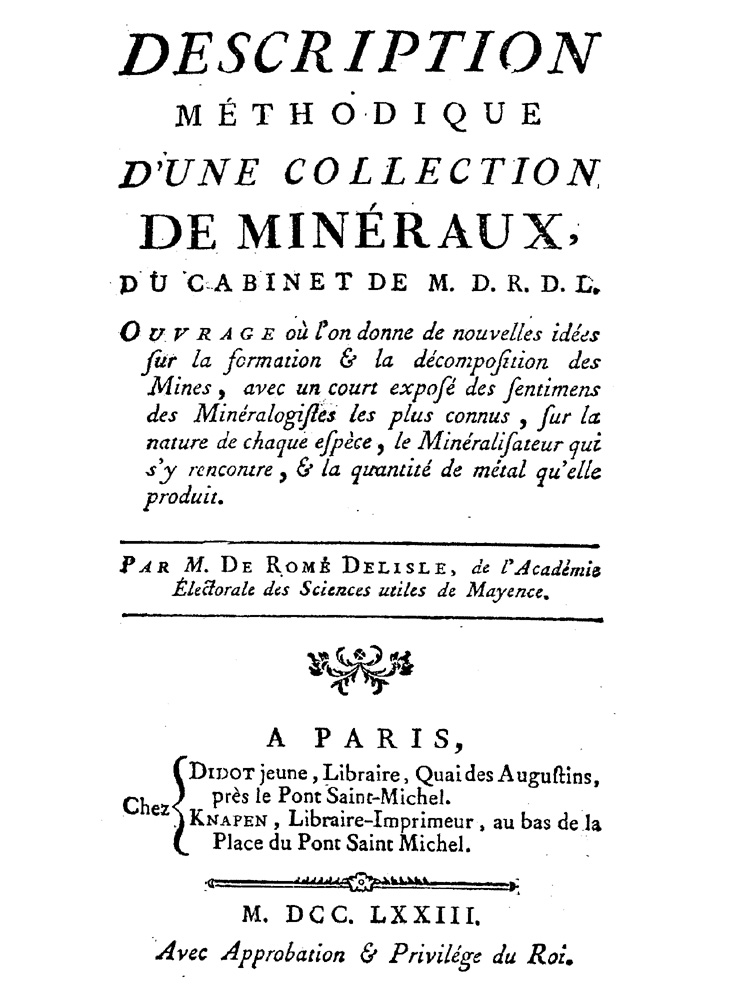
4. French, 1773 [Collection catalog].
Description | Méthodique | D'Une Collection | De Minéraux, | Du Cabinet M.D.R.D.L. | Ouvrage où l'on donne de nouvelles idées | sur la formation & la décomposition des | Mines, avec un court exposé des sentimens | des Minéralogistes les plus connus, sur la | nature de chaque espèce, le Minéralisateur qui | s'y rencontre, & la quanitité de métal qu'elle | produit. | [rule] | Par M. De Romé Delisle, de l'Académie | Électorale des Sciences utiles de Mayence. | [rule] | [ornament] | A Paris, | [The next 4 lines are braced on the left-hand side by "Chez {"] Didot jeune, Librarire, Quai des Augustins, | près le Pont Saint-Michel. | Knapen, Libraire-Imprimeur, au bas de la | Place du Pont Saint Michel. | [ornate rule] | M. DCC. LXXIII. | Avec Approbation & Privilége du Roi.
8°: a-b8 A-T8; 169l.; [i]-xxxij, [1]-299, [5] p., engraved frontispiece. Page size: 200 x 124 mm.
Contents: [i-ii], Half title page, "Description | Méthodique | D'une Collection | De Minéraux, | Du Cabinet De M.D.R.D.L.," verso blank.; [Frontispiece].; [iii-iv], Title page, verso blank.; [v]-xix, "Préface."; xx-xxv, Authorities list.; xxvj-xxxij, "Table Synoptique | Des Mineraux."; [1]-296, Text.; 297-299, "Note relative à la page 169, sur | le Plomb vierge."; [3 pgs], "Table Alphabétique."; [2 pgs], "Approbation" and "Privilege."
Plates: The engraved frontispiece shows the god and goddess with 2 cherubs. It is signed at the base: "C. Monnel inv. del. & Aug. de St. Aubin sculp. 1773." Text at the base reads: "Usus & impigræ simul experientia mentis | Paulatim docuit pedetentim progredientes. | Lucret. de rer. nat. lib. V."
Very scarce. In this collection catalog, the famous French crystallographer fully describes about 750 metallic minerals from his own cabinet. Included are specimens consisting of pure metals as well as natural alloys and combinations with sulfur. Basic division is based upon the principle metals and semimetals contained in the described specimens and include gold, silver, copper, iron, tin, lead, mercury, antimony, zinc, bismuth, cobalt, arsenic and sulfur. Under each of these headings, the specimens are divided based upon their form and chemical composition. For each item described, notes on the origin, associated minerals, locality, size and the estimated weight of contained precious metals is presented. The catalog is well referenced, and if a particular specimen was given to Romé, the supplier's name is included in the description.
During his lifetime, Romé accumulated a large collection of minerals and crystals. Following his death in 1790, it was purchased by François Gillet de Laumont [1747-1834], French Inspector General of Mines and one of the greatest mineral collectors of his time. In 1835, De Laumont's collection was purchased by the French goverment, where today its remains are preserved in Paris at the Sorbonne.
Bibliographical references: Freilich Sale Catalog: no. 464. • Gatterer, Mineralogischen Literatur, 1798-9: 1, 272-3. • Hoover Collection: no. 690. • Jenaische gelehrte Zeitungen: 1774, p. 760. • Laissus, Cabinets d'Histoire Naturelle, 1964: p. 669 ["un véritable manuel de minéralogie"]. • LKG: XV 22a. • Metzger, Genèse de la Science des Cristaux, 1918. • Wilson, History of Mineral Collecting, 1994.
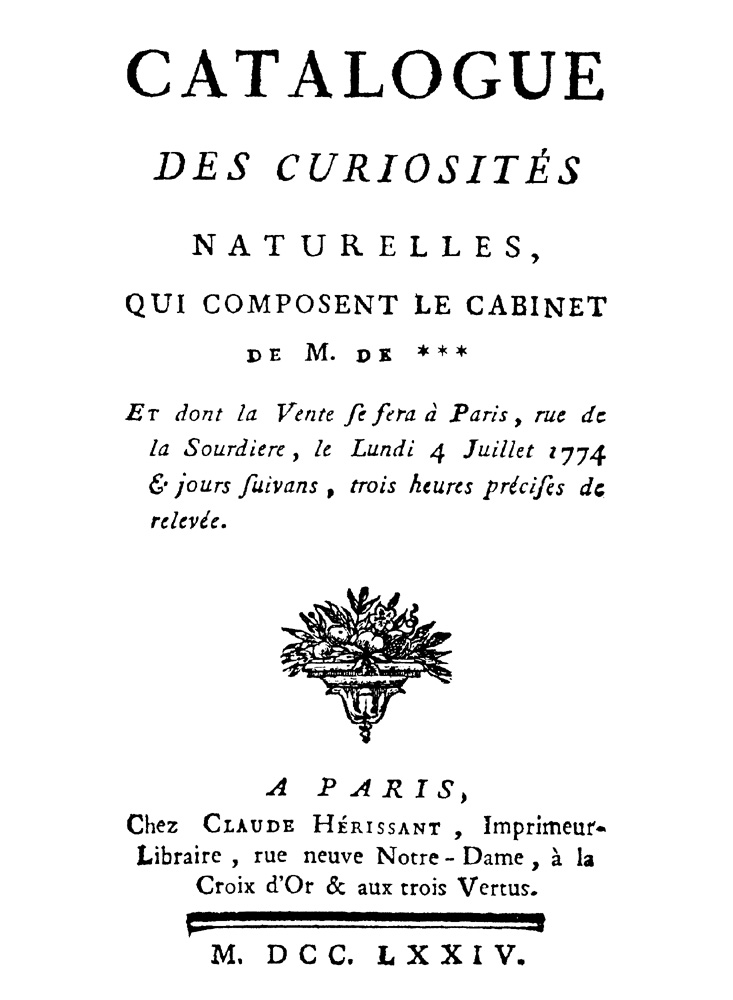
5. French, 1774 [Collection catalog].
Catalogue | Des Curiosités | Naturelles, | Qui Composent Le Cabinet | de M. de *** | Et dont la Vente se fera à Paris, rue de | la Sourdiere, le Lundi 4 Juillet 1774 | & jours suivans, trois heures précises de | relevée. | [ornament] | A Paris, | Chez Claude Hérissant, Imprimeur- | Libraire, rue neuve Notre-Dame, à la | Croix d'Or & aux trois Vertus. | [double rule] | M. DCC. LXXIV.
8°: [2], iv, [vii]-viii, 15, [1], 295 p.
Very rare. Catalog of the Varennes de Béost [see note below] collection of minerals, shells and other natural history items which was sold by the collector's heirs. The sale contained 1430 lots. In the advertisement, Romé provides a brief history of the collection, indictating that it was particularly well represented in specimens from England, Germany, Switzerland and Italy.
Claude-March-Antoine Varennes de Béost. (Born: 1722; Died: Paris, France?, 1788) French bureaucrat. Béost was the French secretary of State for Burgundy and Receiver General of Finances for Brittany. His natural history cabinet was well-known in Dijon as early as 1757, and was prominent in Paris by 1767. Already rich in minerals, the collection was greatly augmented by the incorporation of Savalette de Buchelay's collection in 1764, and part of the chemist Jean Hellot's [1685-1766] collection in 1766.
Bibliographical references: BL [955.d.26.]. • Gatterer, Mineralogischen Literatur, 1798-9: 1, 273. • Jonathan Hill, Bookseller: cat. 20, no. 146. • NUC. • Wilson, History of Mineral Collecting, 1994: 52 & 196. (Varennes de Béost) Wilson, History of Mineral Collecting, 1994: 52 & 196.
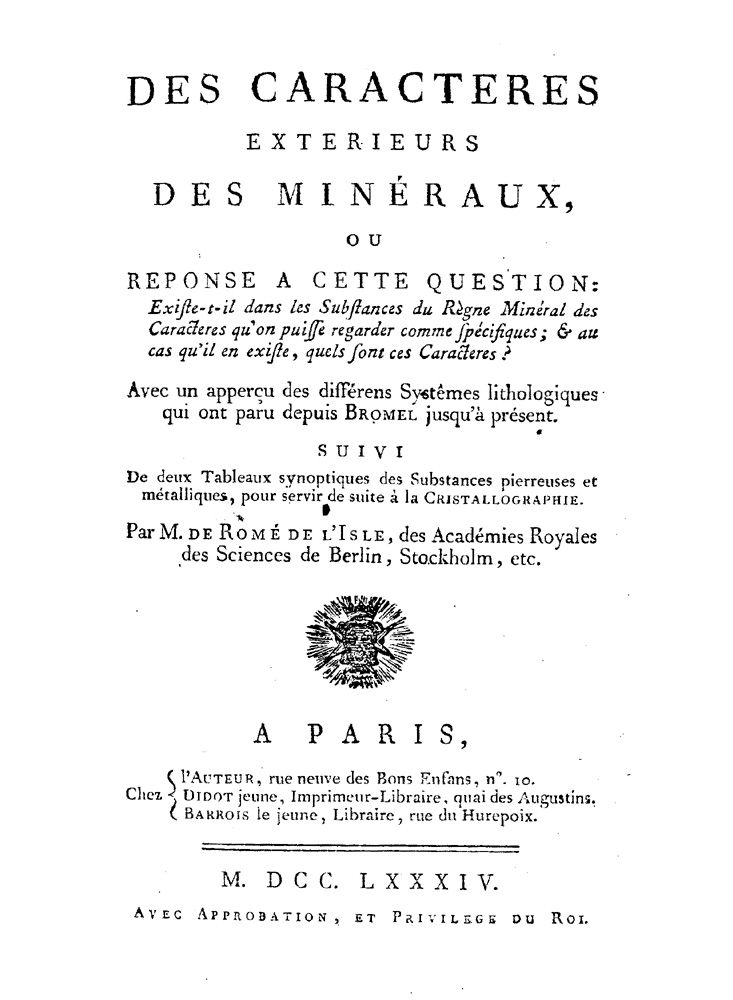
6. French, 1784.
Des Caracteres | Exterieurs | Des Minéraux, | Ou | Response A Cette Question: | Existe-t-il dans les Substances du Règne Minéral des | Caracteres qu'on puisse regarder comme spécifiques; & au | cas qu'il en existe, quels sont ces Caracters ? | Avec un apperçu des différens Systêmes lithologiques | qui ont paru depuis Bromel jusqu'à présent. | Suivi | De deux Tableaux synoptiques des Substances pierreuses et | métalliques, pour servir de suite à la Cristallographie. | Par M. de Romé de l'Isle, des Académies Royales | des Sciences de Berlin, Stockholm, etc. | [ornament] | A Paris, | [The next 3 lines are braced on the left-hand side by, "Chez {"] l'Auteur, rue neuve des Bons Ensans, n°. 10. | Didot jeune, Imprimeur-Librarire, quai des Augustins. | Barrois le jeune, Libraire, rue du Hurepoix. | [double rule] | M. DCC. LXXXIV. | Avec Approbation, et Privilege du Roi.
8°: [4], 82 p., 3 large folding tables.
Very scarce. Brought out as a supplement to his Cristallographie, Romé de L'Isle in this work discusses the importance of external characteristics in mineral identification. The author expresses his opinion that any mineral can be uniquely identified by determining its crystal form, its density and its hardness. It was written to rebut Daubenton, who at the time was giving a series of popluar lectures on mineralogical subjects. In Daubenton's mineralogical theory, since mineral species did not organically propagate, there existed no mechanism for specific characteristics to be passed from one generation to another; therefore, mineral species would never be uniquely identifiable, because they could not exist. When Romé published this volume he was explicitly stating a principal he had implied in the two editions of his great crystallographic work. Namely, that each mineral species was fixed and distinct from every other species. Romé chose as his defining characteristic the constancy of chemical composition, arguing that over time, the invariability of the laws of chemical affinity would be as accurate in determining mineral species as reproduction was in living organisims.
Bibliographical references: Freilich Sale Catalog: no. 465. • Hoover Collection: no. 689. • LKG: IX 10b. • Mauskopf, Crystals and Compounds, 1976: 17. • Metzger, Genèse de la Science des Cristaux, 1918.
Forster Sale Catalogs
7. French, 1769 [Sale catalog].
Catalogue raisonne d'une collection choisie de mineraux, cristallisations, madrepores, coquilles & autres curiosites de la nature & de l'art. La Vente s'en fera le Mardi 4 Avril 1769 & jours suivans .. au grand Hotel de Berri, ... Paris, Chez Delalain, 1769.
8°: v, 128, 6 p. Page size: About 200 x ?? mm. each.
Very rare. "La vente s'en sera le mardi 4 avril 1769 & jours suivans, trois heures précises de relevée, au grand hôtel de Berri, rue S. Thomas du Louvre." Lists 990 items.
Bibliographical references: BL [956.c.29.(1.)]. • LKG: XV 21*. • Metzger, Genèse de la Science des Cristaux, 1918. • NUC: 752, 39 [NR 0015347]. • Wilson, History of Mineral Collecting, 1994: 52 & 210 [reproduces the title page].
8. French, 1772 [Sale catalog].
Catalogue raisonne d'une collection choisie de mineraux, cristallisations, coquilles, Petrifications & autres objects d'histoire naturelle. La Vente sten fera le Lundi 27 Avril 1772, & jours suivans ... a l'Hotel de Warsovie, ... Paris, Chez Didot, 1772.
8°: [2], viii, 269, [2] p.
Very rare. Auction sale catalog of mineralogical, fossil and shell specimens sold by Jacob Forster held in Paris on April 27th, 1772. The catalog lists 1762 lots.
Bibliographical references: BL [956.h.31.].
9. French, 1780 [Sale catalog].
Catalogue raisonné d'une collection de minéraux, cristallisations, pétrifications, coquilles, et autres objets d'histoire naturlle : dont la vente se sera le lundi 21 février 1780, & jours suivans, á l'Hôtel d'Aligre, rue Saint-Honoré: la feuille de distribution des différents articles qui composent ce catalogue, se délivera quelques jours avant la vente. A Paris, Chez Didot jeune ..., 1780.
8°: a6 A-N8 O2; 116l.; [2], x, 220 p.
Very rare. Auction sale catalog of mineralogical, fossil and shell specimens sold by Jacob Forster held in Paris on February 21, 1780. The catalog lists ?? lots.
Bibliographical references: BL [956.c.29.(2.)].
10. French, 1783 [Sale catalog].
Catalogue raisonne d'une collection de mineraux, cristallisations, petrifications, coquilles, et objets d'histoire naturelle; Dont fera le Lundi 17 Fevrier 1783, ... Paris, Chez Didot, 1783.
8°:
Very rare. Auction sale catalog of mineralogical, fossil and shell specimens sold by Jacob Forster held in Paris on February 17, 1783. The catalog lists ?? lots.
Bibliographical references: BL.
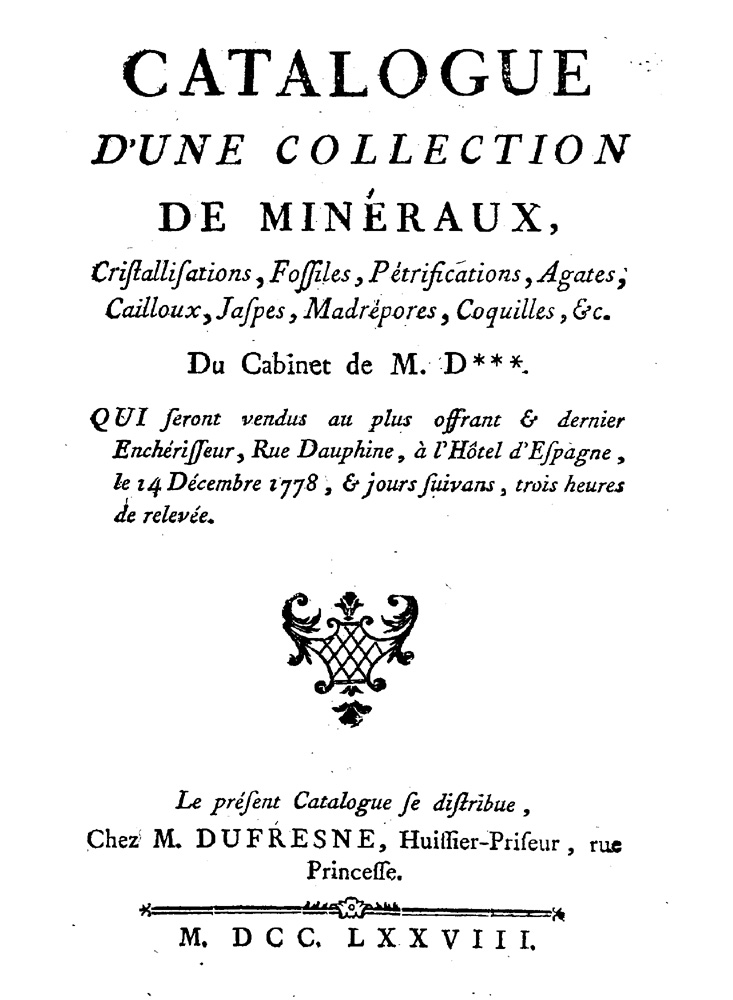
11. French, 1778.
Catalogue | D'Une Collection | De Minéraux, | Cristallistations, Fossiles, Pètrifications, Agates, Cailloux, Jaspes, Madrèpores, Coquilles, &c. | Du Cabinet de M. D ***. | Qui seront vendus au plus offrant & dernier | Enchérisseur, Rue Dauphine, à l'Hôtel d'Espagne, | le 14 Decembre 1778, & jours suivans, trois heures | de relevée. | [ornament] | Le présent Catalogue se distribue, | Chez M. Dufresne, Huissier-Priseur, rue | Princesse. | [ornate rule] | M. DCC. LXXVIII.
8°: A-C8 D2; 26l.; [1]-52 p. Page size: 186 x 114 mm.
Contents: [1-2], Title page, verso blank.; [3]-48, Text.; 49-52, "Feuille De Distribution | Des objects qui sernont vendus les jours margués | ci-après.
Very rare. Catalog prepared by Romé de l'Isle of a mineral and shell collection that was sold on the 14 th of December, 1778 at the Hôtel d'Espagne in Paris. The descriptions indicate that the collection consisted of about 2,000 mineral specimens mostly metalliferous in nature and 1,500 corals, shells and fossils. The owner of the collection remains a mystery; however, it is recorded that the geologist Jean Démest [see note below] apparently had a large mineral collection, and this might be the sale catalog of his cabinet.
Jean Démeste. (Born: 1743; Died: Liége, Belgium, 20 August 1783) Belgian physician, geologist & mineralogist. Démeste was a medical doctor, principally a surgeon to the Army troops of the Bishop-Prince of Liège. His intensive study of chemistry gained him membership in many learned societies.
Bibliographical references: NUC: 752, 39 [NR 0015347]. • Wilson, History of Mineral Collecting, 1994: 52 & 210. (Démeste) ABF: I 300, 211-212. • BAB: I 182, 254-263 / 461, 292. • Biographie Universelle: 11, 28. • Laissus, Cabinets d'Histoire Naturelle, 1964. • Nouvelle Biographie Générale (Hoefer): 13, 527. • Poggendorff: 1, col. 548. • Stouffs, Inventaire des Papiers du Didot, 1963. • WBI.
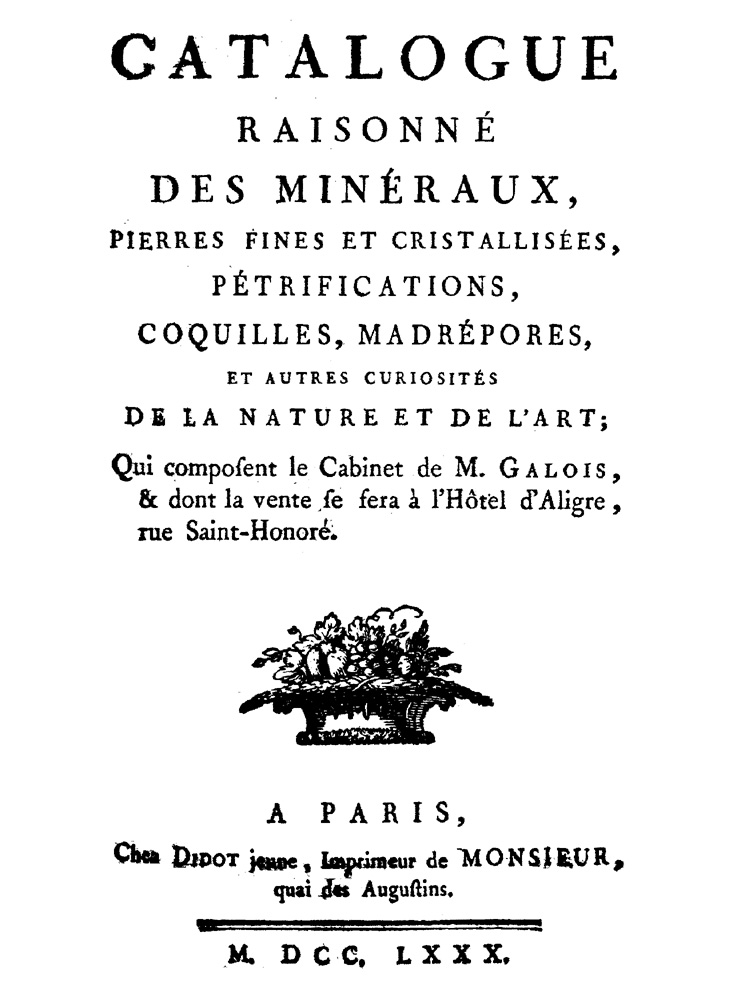
12. French, 1780 [Collection catalog].
Catalogue | Raisonné | Des Minéraux, | Pierres Fines Et Cristallisées, | Pétrifications, | Coquilles, Madrépores, | Et Autres Curiosités | De La Nature De L'Art; | Qui composent le Cabinet de M. Galois, | & don't la vente se fera à l'Hôtel d'Aligre, | rue Saint-Honoré. | [ornament] | A Paris, | Chez Didot jeune, Imprimeur de Monsieur, | quai des Augustins. | [double rule] | M. DCC. LXXX.
8°: a4 A-L8 M6; 98l.; [i]-viii, [1]-188 p. Page size: 194 x 116 mm.
Contents: [i-ii], Title page, verso blank.; iii-vj, "Avertissement."; [vii]-viij, "Table."; [1]-188, Text.
Rare. Catalogue of the Gallois mineral collection. Gallois had previously acquired the natural history cabinet of a Mr. Bellanger, director of a tobacco company in Paris. To this he added other specimens, particularly minerals, precious stones, and crystallized specimens. In this work, Romé de l'Isle catalogued 1647 items, presumably for a sale at auction. The first 109 pages list specimens of mineralogical interest and include suites of native gold, silver, and copper, as well as minerals containing lead, tin, iron, mercury, antimony, pyrites, petrifications, crystallized calcite and quartz, agates, jaspers, figured stones and precious and semiprecious stones.
An earlier edition of the catalog probably not compiled by Romé de l'Isle was published in 1773 [which see entry under Gallois].
Bibliographical references: Wilson, History of Mineral Collecting, 1994: 212.
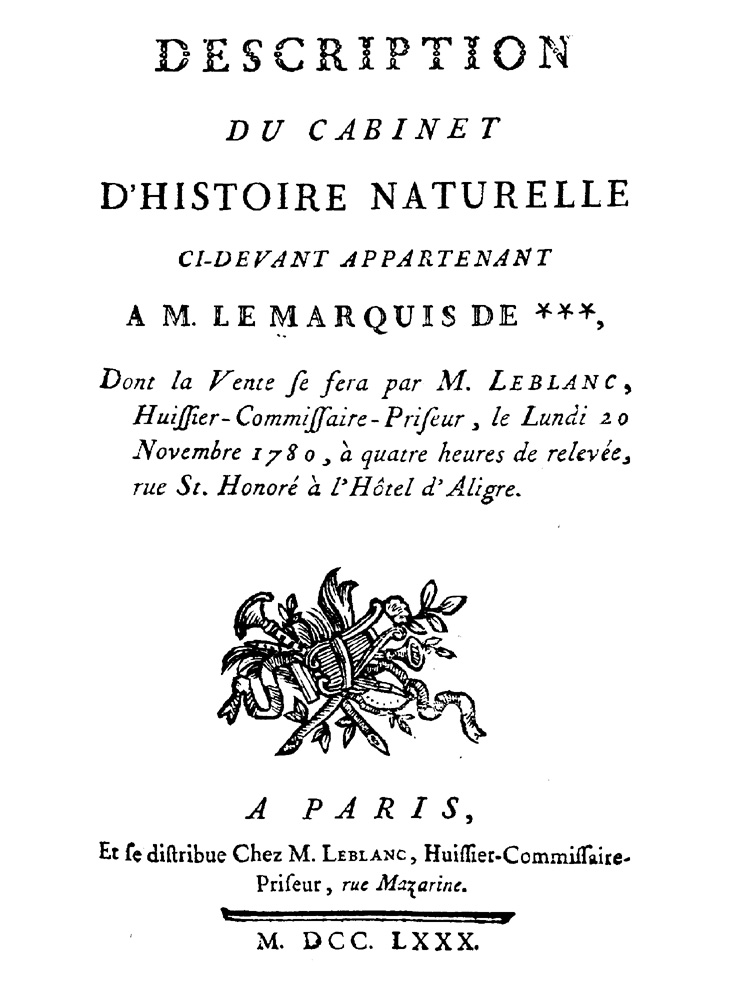
13. French, 1780 [Sale catalog].
Description | Du Cabinet | D'Histoire Naturelle | Ci-Devant Apartenant | A M. Le Marquis De ***, | Don't la Vente se fera par M. Leblanc, | Huissier-Commissaire-Priseur, le Lundi 20 | Novembre 1780, à quatre heures de relevée, | rue St. Honoré à l'Hôtel d'Aligre. | [ornament] | A Paris, | Et se distribue Chez M. Leblanc, Huissier-Commissaire- | Priseur, rue Mazarine. | [double rule] | M. DCC. LXXX.
8°: π2 A-K8 L2; 84l.; [i]-iv, [1]-164 p. Page size: 194 x 118 mm.
Contents: [i-ii], Title page, verso blank.; iij-iv, "Advertisement."; [1]-164, Text.
Rare. Auction sale catalog of the natural history collection of the Marquis de Gouffier, which contained a significant mineralogical component (pp. 1-98). The collection had numerous mineral specimens and crystallizations. Specimens were from worldwide in nature with many from Asia and South and North America, as well as the expected European localities. The sale occurred on November 20th, 1780 at the Hôtel d'Aligre. Although the title page does not state it, Gouffier's name is invoked on the first page of the catalog.
Bibliographical references: Wilson, History of Mineral Collecting, 1994: 52, 173 & 213.
Manuel cristallographie, ou abrégé de la cristallographie de M. Romé de l'sle. Avec une méthode facile pour connoítre les différentes cristallisations des mixtes qui composent un cabinet de minéralogie, aidé par une collection de Poliédre dont cet ouvrage est aussi une explication ... (Paris, 1792).See under: Des Fontaines, Swebach (réné Louiche)..
